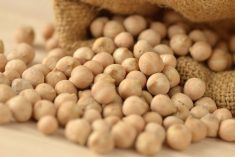MarketsFarm — A return to yields closer to long-range averages will result in greater production for most pulse crops in 2022-23, according to Agriculture and Agri-Food Canada’s monthly outlook for principal field crops released last Friday.
Many of the projections are based on the assumption that normal weather conditions will return to most of the Prairies after two years of drought.
“Timely rains and more average temperatures this spring and summer could lead to improved yields for all pulses, when compared to last year,” said Bobby Morgan, pulse and special crops analyst for AAFC.
Read Also

Pulse weekly: Record Australian pulse crop expected
Australian pulse production is expected to set a record for the second year in a row in 2025/26, with a slight decline in the chickpea crop countered by increased lentil production, said the Australian Bureau of Agricultural and Resource Economics (ABARES) in its December crop report.
Production for dry peas is expected to increase 55 per cent to 3.5 million tonnes in 2022-23. As production increases, exports typically follow as 2.7 million tonnes is forecast to be shipped out of the country, compared to 2.1 million last year. Carryout stocks are projected to double to 300,000 tonnes at the end of the crop year.
Lentil production is projected to rise 59 per cent to 2.55 million tonnes with Saskatchewan expected to grow 89 per cent of Canada’s lentil crop. Exports are projected to increase 40 per cent compared to 2021-22 to 2.1 million tonnes, while carryout is forecast to be 40 per cent higher at 350,000 tonnes.
Chickpea production is forecast to expand by 44 per cent to 110,000 tonnes, but lower demand and lower prices have reduced the projected export total by 25 per cent to 120,000 tonnes. Carryout is expected to decline 20 per cent, also to 120,000 tonnes.
Record export prices have turned some countries away from dry beans, resulting in lower demand for the Canadian crop. Production will decline by 15.9 per cent to 325,000 tonnes. Carryout is forecast to tighten by 18.8 per cent to 130,000 tonnes, despite exports slightly rising to 360,000 tonnes.
So far this year, the Prairies have been on opposite ends of soil moisture with the west still seeing drought conditions and the east becoming waterlogged. However, Morgan is unsure whether production estimates will change because of the conditions.
“At this point, it is too early to assess the impact of current weather events on this year’s crop,” he added.
The next AAFC outlook for principal field crops is expected to be released on June 21. Statistics Canada is scheduled to publish final area estimates for principal field crops on June 29.
— Adam Peleshaty reports for MarketsFarm from Stonewall, Man.















